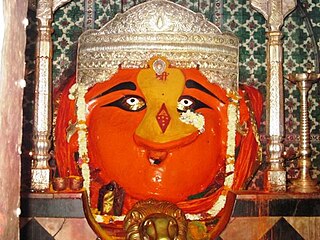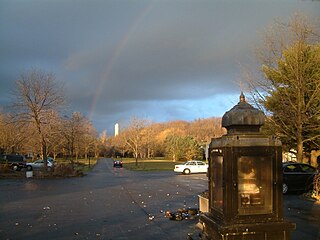
Shaktism is a major Hindu denomination in which the godhead or metaphysical reality is considered metaphorically to be a woman.

Bhadrakali is a Hindu goddess. She is considered to be the auspicious and fortunate form of Adi Shakti who protects the good, known as Bhadra.

Amāvásyā is the lunar phase of the new moon in Sanskrit. Indian calendars use 30 lunar phases, called tithi in India. The dark moon tithi is when the Moon is within 12 degrees of the angular distance between the Sun and Moon before conjunction (syzygy). The New Moon tithi is the 12 angular degrees after syzygy. Amāvásyā is often translated as new moon since there is no standard term for the Moon before conjunction in English.

Renuka, also known as Yellamma, is a Hindu mother Goddess worshipped predominantly in the South Indian states of Karnataka, Tamil Nadu, Telangana, Kerala, Andhra Pradesh and the western state of Maharashtra. She is the mother of Parashurama, the sixth avatar of god Vishnu. She was given the name "Renuka" and acquired the status of a mother goddess before eventually being associated with the legend of Parashurama.

Somarama is one of the five Pancharama Kshetras that are sacred to the Hindu god Shiva. The temple is located in Bhimavaram of West Godavari district in the Indian state of Andhra Pradesh. It is one of the centrally protected monuments of national importance.

The Arulmigu Sri Mahamariamman Temple is a Hindu temple within George Town in the Malaysian state of Penang. The oldest Hindu temple in the state, it was built in 1833, and features sculptures of gods and goddesses over its main entrance and facade.

The Maa Sarala Temple is a Hindu temple in the district of Jagatsinghpur, Odisha, India. It is one of the eight most famous Shakta shrines of Odisha.

The Shree Vajreshwari Yogini Devi Mandir is a Hindu temple dedicated to the goddess Vajreshwari, located in the town Vajreshwari, 75 km away from Mumbai. The town, earlier known as Vadvali, was renamed Vajreshwari in honour of the presiding deity of the temple.

The Rajarajeswari Peetam in Rush, New York is a Sanathana Dharma temple that practices the teachings of SriVidya. Sri Chaitanyananda Natha Saraswathi is the peetathipathy of the temple along with Gnanamba his wife. Aiya is a disciple of Sri Amritananda Natha Saraswathi who is the Peetathipathy of the Devipuram temple. The temple was founded in Zambia, then moved to the Aiya's home in Rush in New York state before the current, purpose-built temple was constructed.
Bengaluru Karaga is an annual festival celebrated in the Tigalare Pete, primarily by the Vahnikula Kshatriya or Thigala community. Based on story of their heritage, they built temples for Draupadi and Dharmaraya (Yudhishthira). Adishakti Draupadi is the community Deity of the Vahnikula Kshatriyas, one of the foremost communities in Karanataka state. The Dharmaraya Swamy Temple itself is more than 800 years old. It was built by the Vahnikula Kshatriyas, one of the city's oldest communities that was into agriculture and horticulture. The Karaga festival is generally led by the Vahnikula Kshatriyas. Karaga is one of the many traditions of worshiping Adisakti Draupadi Devi. Karaga pooja and festivals have been celebrated in Tamil Nadu and Karnataka since ages. Its practice is in use in some parts of Kolar district and Bangalore in the state of Karnataka. It is learnt that there are forty lakh people belonging to the Vahnikula Kshatriya community living throughout the state: Hoskote, Malur, Kolar, Bengaluru and Anekal taluks have high populations of the Vahnikula Kshatriya community in both urban and rural areas. Basically, this community depends upon agricultural and horticultural activities.
Boyakonda Gangamma in the location of temple to Gangamma Devi at Boyakonda, Andhra Pradesh 517257, 20 km from Madanapalle and 150 km from Bangalore; it is in the Chowdepalli Mandal, Diguvapalli panchayat, Pungunur taluk, Chittoor district, Andhra Pradesh State of India. There is also a Hindu Pilgrimage centre here.

Navaratri is an annual Hindu festival observed in honor of the goddess Durga, an aspect of Adi Parashakti, the supreme goddess. It spans over nine nights, first in the month of Chaitra, and again in the month of Ashvin (September–October). It is observed for different reasons and celebrated differently in various parts of the Hindu Indian cultural sphere. Theoretically, there are four seasonal Navaratris. However, in practice, it is the post-monsoon autumn festival called Sharada Navaratri. There are 2 Gupta Navaratris or "Secret Navaratris" as well, one starting on the Shukla Paksha Pratipada of the Magha Month and another starting in the Shukla Paksha Pratipada of Ashadha Month.

Kali Puja, also known as Shyama Puja or Mahanisha Puja, is a festival originating from the Indian subcontinent, dedicated to the Hindu goddess Kali. It is celebrated on the new moon day of the Hindu calendar month of Ashwayuja or Kartika. The festival is especially popular in the region of West Bengal, and other places like Mithila, Jharkhand, Odisha, Assam, and Tripura, as well as the town of Titwala in Maharashtra, along with the neighbouring country of Bangladesh.

Saraswathi Kshetramu is a Hindu Temple of Goddess Saraswathi located in the Ananthasagar, Chinna Kodur Mandal, Siddipet Division, siddipet district of Telangana. The temple was built on Friday, 2 May 1980 by Astakala Narasimha Rama Sharma (Astavadhani). It is located between Siddipet to Karimnagar, 22 km away from the former, 125 km from Hyderabad and 63 km from Medak,.
Sri Sri Nookambika Ammavari Temple or Sri Nookallamma Ammavaari Devasthanamu, is a temple located in Gavarapalem in the municipality of Anakapalli near the southeastern coast of India.

Mulavar or Mula-murti is a Sanskrit-Tamil term referring to the main deity, or a murti in a Hindu temple.

Pallikondeswara Temple(also Pradosha kshetram) is a Hindu temple dedicated to the god Shiva located in Surutupalle, a village in Tirupati district of Andhra Pradesh, India. The presiding deity Pallikondeswara, unlike other Shiva temples, is sported in reclining posture lying on the lap of his consort Parvati.
Here is a list of glossary of Culture of India in alphabetical order:

The Kurmanathaswamy temple, also known as the Kurmanatha temple, Srikurma or Srikurmam temple, is a Hindu temple dedicated to Kurma – the second avatar of Vishnu. It is located in Srikurmam village, Srikakulam district in Andhra Pradesh, India. According to Prapannamrutam and earliest inscription of the temple, In saka 1035 CE Anantavarman Chodaganga Deva of Eastern Ganga Dynasty of Odisha converted this temple to a Vaishnava khetra from a Siva temple.The temple was Built before 11th-century CE in a fusion architecture of kalinga Architecture and Dravidian Architecture. The temple's perambulatory were constructed by Eastern Ganga Dynasty king Anangabhima Deva III, and it is dedicated to Vishnu as Kurmanathaswamy and his consort Lakshmi as Kurmanayaki. The temple has century old Orissan Pattachitra style mural paintings in side wall of pradakshina mandapa.

Sri Ramalinga Sowdeshwari Amman, commonly abbreviated to Sowdeshwari, is a Hindu folk deity, regarded by adherents to be a regional form of either Mahadevi or Parvati. She is considered to be the Kuladevata of the Devanga people.

















